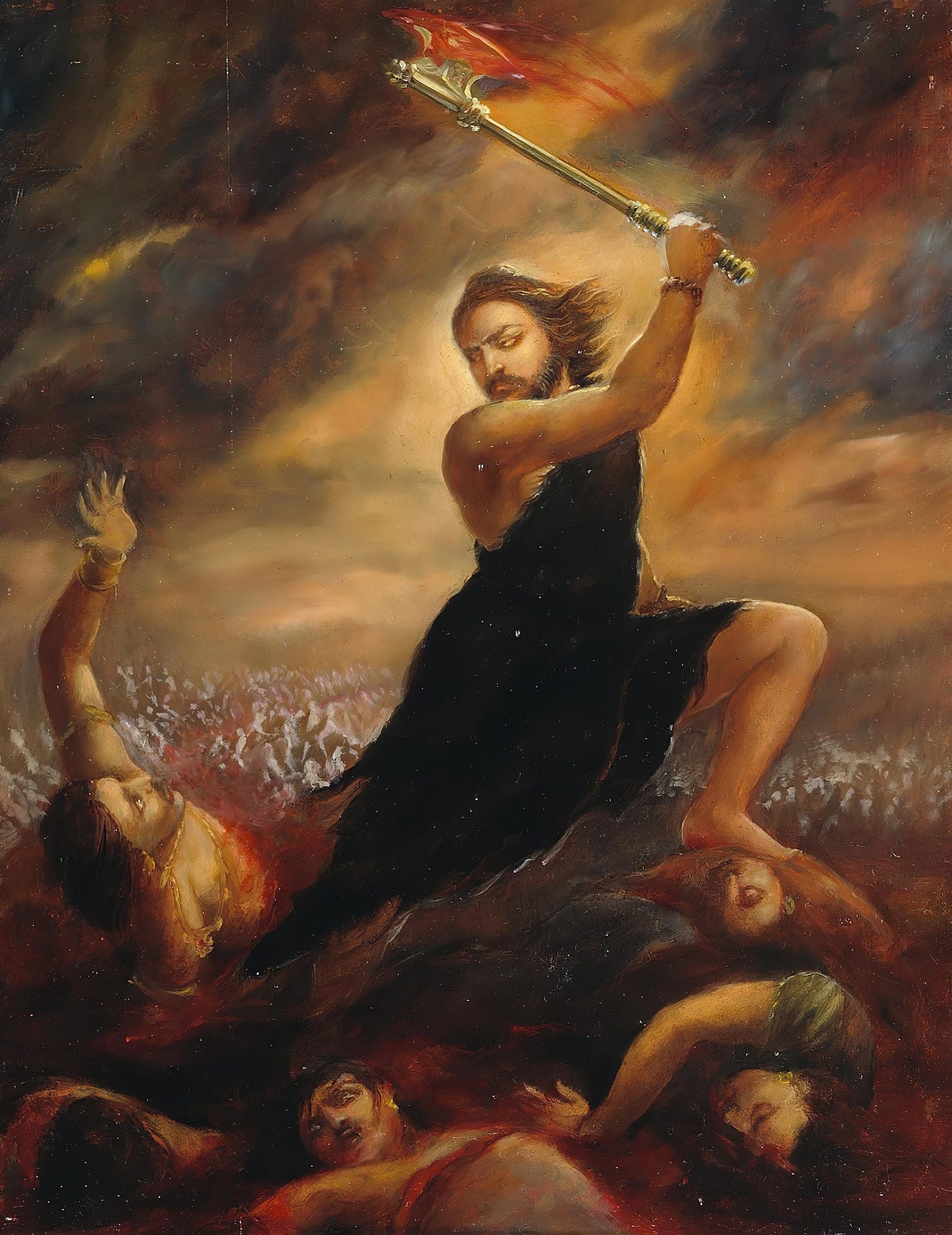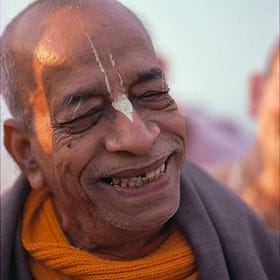Cutting through misconceptions in studying the scriptures
A view on the philosophical debates behind the conclusions that Prabhupada gives us already chewed over in his books.
The idea of Paramātmā, the Lord inside the heart accompanying the soul in his trip in the material universe, may sound clear and natural for a reader of Prabhupada's books, but this idea is actually not clearly understood in most philosophical schools based on the Vedas. This is another example of how it is difficult to grasp the true meaning of the scriptures without the help of a self-realized soul.
Let’s take this passage from the Kaṭha Upaniṣad (1.3.1), for example:
ṛtam pibantau sukṛtasya loke guhām praviṣṭau parame parārdhe
chāyātapau brahma-vido vadanti pañcāgnayo ye ca tri-ṇāciketāḥ"The knowers of Brahman, who tend the five fires and perform the threefold nāciketa sacrifice, speak of the two beings who have entered the cave of the heart, the most excellent space, for performing pious deeds and experiencing the results of karma. They describe them as like shadow and light."
We can see that this passage describes a companion for the soul inside the heart. Because the verse is vague in defining who He is, it's possible to interpret the companion as being either buddhi, prāna, or the Supersoul. Superficially, it appears that buddhi or prāna may make more sense because the heart is a small space, and thus, how could it be the abode of the Supreme Brahman? In fact, the word "guhām" actually means "cave", confirming the analogy.
Another possible argument in this line is that in the verse from the Kaṭha Upaniṣad, it is mentioned that they experience the results of karma, suggesting that the companion assists the jīva as he experiences the inevitable results of his karma. In this way, it could be argued that the companion can't be the Lord, because He never experiences the results of karma. Following this logic, the companion must be either buddhi or prāna, which negates the existence of the Supersoul. This would be a common conclusion in the Nyāya and Mīmāṁsā schools, where the existence of the Supersoul is not accepted.
Māyāvādis don't directly negate the existence of the Supersoul, but they interpret it in the light of the saguṇa Brahman theory. They accept the Supersoul, but don't see Him as the transcendental Lord, but as a manifestation observed through Maya. For them, Paramātmā is not the original, transcendental Lord, but Brahman covered by material attributes.
How does it work? According to them, Brahman is present inside the heart as antaryāmi, acting as a witness and dispenser of the results of karma, as well as an object of meditation. This, they say, is Brahman viewed under the upādhi of māyā, and not nirguṇa Brahman, which is pure, attributeless consciousness. According to them, when the avidyā is removed by the cultivation of spiritual knowledge, one sees oneself in one's original nature, as Brahman. In other words, their interpretation is that the references to the soul and Paramātmā inside the heart are merely pedagogic, since they are ultimately one. To sustain this view, they use examples such as the same sun reflected in two pots of water and the air inside a pot being temporarily separated from the atmosphere, but at the same time, one with it.
Sounds complicated? In fact it is, just as most other Māyāvādi interpretations. This is due to Śankarācārya and other commentators trying to cover the direct conclusions of the scriptures.
Once we understand the correct conclusion of Paramātmā as the Supreme Lord in His transcendental form, accompanying the soul inside the heart, both theories are countered.
While it's possible to try to sustain the thesis of the companion being buddhi or prāna using the Kaṭha Upaniṣad 1.3.1 alone, this thesis falls apart when confronted with other references. In other passages, the scriptures are very clear in defining the companion as the Supersoul. In the Kaṭha Upaniṣad 1.2.12, for example, it's mentioned:
tam durdarśam gūḍham anupraviṣṭam
guhāhitam gahvareṣṭam purāṇam
adhyātma-yogādhigamena devam
matvā dhīro harṣa-śokau jahāti"That primeval and beginningless Supreme Lord, who is subtle, hidden, and difficult to perceive, who has entered into the heart of all beings, situating Himself in their very core, that Supreme Self is realized in the trance of transcendental yoga (adhyātma-yoga). Knowing Him as the indwelling Self (antaryāmī), the wise one transcends both joy and sorrow."
In this verse, the word "purāṇam" (primeval) can be used only in connection with the Supreme Lord or the soul, but not in connection with buddhi or prāna, which are material manifestations and have thus been created at a certain point, at the beginning of the universe. Only something eternal can be called primeval, as defined by Krsna in Bg 2.20. The word "devan" (divine being) is also an explicit theistic term, indicating the Supreme Lord, just as anupraviṣṭam (He who has entered into all beings), since only the Lord can simultaneously enter into all hearts.
The specific use of these words makes the argument of the companion of the jīva being buddhi or prāna untenable. Both are material manifestations and are not situated in the cave of the heart mentioned in the passage, but outside of it, as part of the subtle body. One could try to insist on the Māyavadi idea of the jīva and Paramātmā being ultimately one, but this last argument is defeated by the words "guhāhitam gahvareṣṭam" (placed in the innermost depths of the cave, and sought of) which clearly define the Lord as the object of meditation of the jīva, and thus separate from it. This gains even more strength with the word "devam", in the next line, which gives even more strength to the idea of a perfect being, different from the jīva, who must be realized by the individual soul.
In this way, it's not possible to misinterpret the verse to suggest that the companion is anyone else apart from the Supersoul. And this is just one reference of many.
At this point, the opponent could try to save face by holding to the words "ṛtam pibantau sukṛtasya loke" in the Kaṭha Upaniṣad 1.3.1, which describe the two selves entering the body to perform pious deeds and then enjoying the karmic results of these acts. Since the Supreme Brahman is pure and performs no material actions, one could argue that this must thus apply to the individual soul, accompanied by buddhi or prāna.
Srila Baladeva Vidyābhūṣaṇa, however, argues that the word pibantau (they drink, in the sense of drinking the results of karma) is used in the sense of they being together, and not in the sense of both enjoying the karmic results. This usage is similar to when we say “the two carriers of the umbrella”. Although only one is factually carrying the umbrella, they are still referred to as “the two carriers of the umbrella” because the two are walking together. Similarly, when it is said "ṛtam pibantau sukṛtasya loke", it means that Paramātmā accompanies the jīva in his material suffering and enjoyment, as a neutral witness, with just the jīva being involved in material actions.
In this way, the argument of the second self not being the Supreme Lord because of performing material actions is fully invalidated. The Lord is the source of the material nature, including karma, and thus He never becomes entangled in it.
In Śrīmad-Bhāgavatam (4.28.54-55), it's mentioned:
hamsāv aham ca tvam cārya, sakhāyau mānasāyanau
abhūtām antarā vaukaḥ, sahasra-parivatsarān
sa tvam vihāya mām bandho, gato grāmya-matir mahīm
vicaran padam adrākṣīḥ, kayācin nirmitam striyā"My dear gentle friend, both you and I are exactly like two swans. We live together in the same heart, which is just like the Mānasa Lake. Although we have been living together for many thousands of years, we are still far away from our original home. My dear friend, you are now My very same friend. Since you left Me, you have become more and more materialistic, and not seeing Me, you have been traveling in different forms throughout this material world, which was created by some woman."
In his purport to ŚB 5.20.5, Srila Prabhupada gives a different translation for the Kaṭha Upaniṣad 1.3.1, focusing on the deep meaning, instead of the literal translation of the words. His interpretation makes the real meaning very clear:
“O Nāciketā, the expansions of Lord Viṣṇu as the tiny living entity and the Supersoul are both situated within the cave of the heart of this body. Having entered that cavity, the living entity, resting on the chief of the life airs, enjoys the results of activities, and the Supersoul, acting as witness enables him to enjoy them. Those who are well-versed in knowledge of Brahman and those householders who carefully follow the Vedic regulations say that the difference between the two is like the difference between a shadow and the sun.”
This is just one more example of the philosophical debates behind the conclusions that Prabhupada gives us, already chewed over in his books. A skeptic may have to go through five thousand years of literature to find these conclusions, and probably get lost in the way, while someone who just accepts quickly absorbs all the right conclusions from the scriptures, and has his or her spiritual path wide-opened.
Read also:
How Prabhupada gives us the proper conclusions of the scriptures
Some think that Prabhupada didn't want us to study anything apart from his books. However, when we carefully study different passages, we see that this is not exactly the case. Prabhupada mentioned on different occasions that he wanted us to study important Vaishnava books, like the Jaiva Dharma, Brhad Bhagavatamrta, the Sat-Sandarbhas, and so on. However, he was also very concerned with devotees studying these books at the right time and with the proper mentality, after getting a good understanding of Vaishnava philosophy from his own books.
If you read this article to the end, give it a like. This makes Substack recommend it to more people.




Hare krsna prabhuji. Thank you for writing this article.Its amazing to see how many different things are stated in scriptures and how many allegories are given , but Srila Prabhupad destroys all misconceptions and gives best possible meaning. Thank you for bringing this to light.Jaya Srila Prabhupad